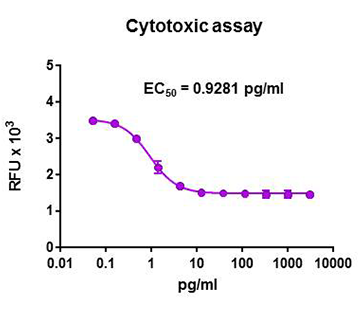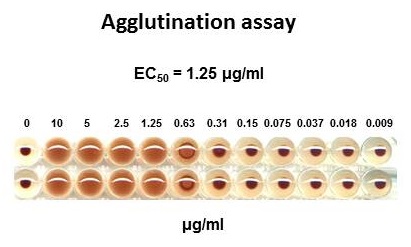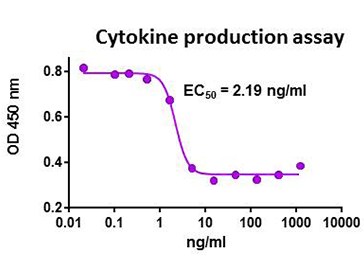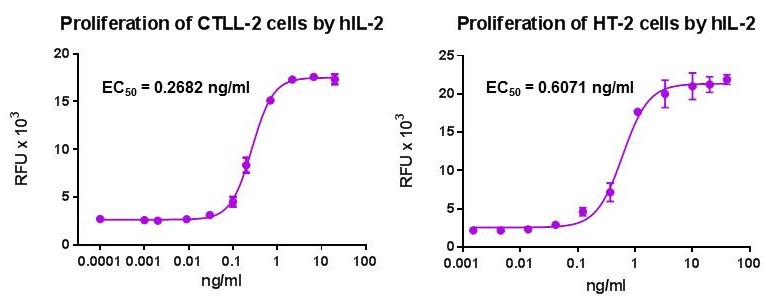Answers to 5 Common Questions about the Activity of Recombinant Proteins
 |
| Many of you often use recombinant proteins to address scientific questions related to cell function and behavior in different research models. However, you may still be puzzled about what the terms specific activity, ED50, and International Units (IU) mean and how these measures correlate with each other. In this blog, we will touch base on the fundamentals of protein biological activity and discuss the most common questions about this topic. |
| 1. How is protein biological activity measured? |
| The biological activity of recombinant proteins is usually provided in units per mass (μg or mg) and is routinely measured using a bioassay. The range of assays that can be used to measure the biological activity of proteins include cell proliferation assays, cytotoxic assays, binding assays, ELISAs, and chemotaxis. Figure 1 represents a few methods we use in-house to measure the biological activity of our recombinant proteins. In order to calculate the specific activity of a protein you need to get the ED50. The ED50 represents a protein concentration measured in ng/ml required to elicit a 50% maximum response in a specific bioassay. This method of expressing activity should only be used for proteins whose dose-response curves are sigmoidal in shape. The following formula can be used to transform the ED50 to specific activity: Specific Activity (Units/mg) = 1 x 106 / ED50 (ng/ml) |
 |
 |
| A. Cytotoxic effect of mouse TNFα on the L929 mouse fibroblast cell line in the presence of actinomycin D measured by Deep Blue Cell Viability Kit. | B. Cell adhesion of Calcein-AM labeled Jurkat cells to immobilized human Galectin-9. |
 |
 |
| C. RBC agglutination in the presence of human Galectin-9. | D. Inhibition of mouse TNFα production by mouse TRANCE. |
Figure 1. Examples of in-house assays used by BioLegend to measure the biological activity of our recombinant proteins |
| 2. Can the ED50 calculated in the assay A be used in assay B? |
| No. The specific activity of a certain protein may differ depending on the assay and cell type used. For example, Recombinant Human IL-2 can activate proliferation of IL-2 dependent cell lines, CTLL-2 and HT-2. The same lot of recombinant protein provides different ED50 values depending on the cell line used for stimulation. In the CTLL-2 stimulation assay, the ED50 is 0.26 ng/ml corresponding to a specific activity of 3.73 x106 units/mg. Because the HT-2 cell line is more sensitive to IL-2 proliferation, the ED50 in the dose-dependent stimulation of HT-2 cells is 0.6 ng/ml, corresponding to a specific activity of 1.65x 106 units/mg (Figure 2). Since our products are used for many different purposes, it is impossible to provide the ED50 for every possible experimental scenario. Our standard bioassay is used to confirm the biological activity of the protein. Therefore, we recommend that the end-user test each lot of the protein and each new set of experimental conditions in a dose response experiment to determine the concentrations that work best for their specific assays. |
 |
| Figure 2. Dose-dependent proliferation of CTLL-2 and HT-2 cell lines in response to human IL-2 |
| 3. Why is the ED50 provided as a range? |
| You may have noticed that the Technical Data Sheet of our recombinant proteins provide the range for ED50 and specific activity. Why? We have stopped issuing the exact specific activity values for each lot of recombinant protein, in part, because the exact activity values on a per Unit basis can largely fluctuate depending on a number of factors, including the nature of the assay, cell density, cell passage number, culture media, and end-user technique. Given these variables, providing an exact activity value may be misleading. |
| 4. Is the specific activity reported in units/mg is the same as the International Units (IU/mg)? |
| International units are assigned to international standards provided by the World Health Organisation (WHO). International standards are manufactured according to WHO guidelines and serve as a 'gold standards' that can be used by different manufacturers or end-users to calibrate their own products. Our experimental ED50 and specific activities are not directly related to or convertible to International Units (UI or IUs), as our testing procedure does not follow the International Standard set by the WHO. The best way to determine how the specific activity of our reagents converts to IUs would be to acquire a known IU reagent and perform an experiment side-by-side with our recombinant protein to see how they compare. |
| 5. Can the recombinant proteins from different vendors be compared using size or units? |
| As mentioned earlier, recombinants derived from different vendors may have different activity per μg or mg size. Different suppliers may have their own method of defining a unit. In order to compare the biological activity of proteins from different vendors, their activity should be compared side-by-side in a titration experiment using the same bioassay. Hopefully we were able to clear up any confusion related to the biological activity of recombinant proteins. If you still have questions related to this topic please contact us at tech@biolegend.com. |
| Contributed by Ekaterina Zvezdova, PhD. |
 Login/Register
Login/Register 






Follow Us